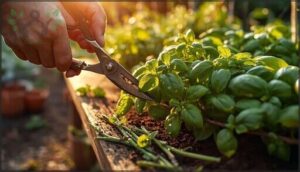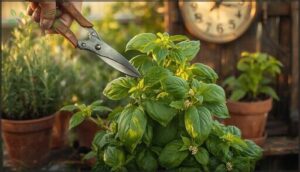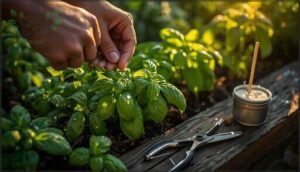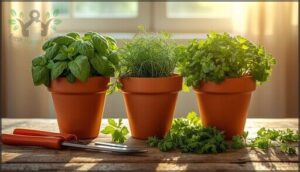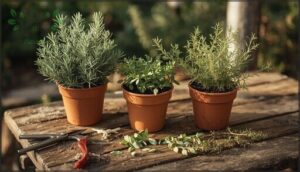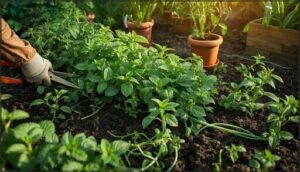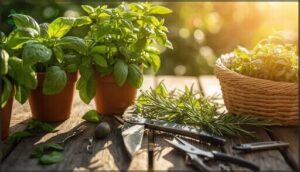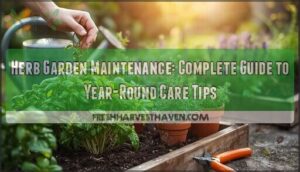This site is supported by our readers. We may earn a commission, at no cost to you, if you purchase through links.
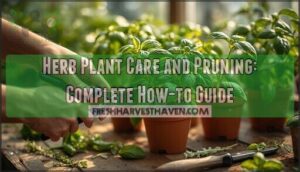
Your herb garden can shift from scraggly and flavorless to lush and aromatic in just a few weeks—if you know where to make the cuts. Most gardeners wait too long to prune, watching their basil bolt or their rosemary grow leggy, then wonder why the harvest tastes bland.
The truth is that pruning isn’t just about tidying up plants. It redirects energy into leaf production, concentrates essential oils, and triggers branching that doubles your yield.
Learning proper herb plant care and pruning techniques means understanding what each plant needs, from how much sunlight fuels flavor to when a 45-degree cut heals faster than a blunt chop. Once you master these fundamentals, you’ll keep your herbs vigorous, flavorful, and productive all season long.
Table Of Contents
- Key Takeaways
- Essential Herb Plant Care Basics
- Why Pruning Herbs is Important
- When and How Often to Prune Herbs
- Pruning Techniques for Leafy Herbs
- Pruning Woody and Perennial Herbs
- How to Prune Basil, Parsley, and Cilantro
- How to Prune Rosemary, Thyme, and Tarragon
- Managing Fast-Growing and Invasive Herbs
- Best Practices and Tools for Herb Pruning
- Frequently Asked Questions (FAQs)
- Conclusion
Key Takeaways
- Pruning redirects plant energy from flowering to leaf production, concentrating essential oils and doubling harvest yields when you cut stems at 45-degree angles above leaf nodes every 1-6 weeks depending on the herb variety.
- Fast-growing leafy herbs like basil need weekly pinching to prevent bolting, while woody perennials like rosemary require monthly trimming of green stems only—never cut into old wood or remove more than one-third of growth at once.
- Most culinary herbs demand 6-8 hours of direct sunlight daily, well-draining soil with pH 6.0-7.0, and watering schedules that let soil dry slightly between sessions to maximize flavor and prevent root rot.
- Clean, sharp tools disinfected with 70% rubbing alcohol between cuts prevent disease spread, and harvesting herbs mid-morning after dew evaporates preserves essential oils that define flavor intensity.
Essential Herb Plant Care Basics
Before you think about pruning, you need to get the basics right. Healthy herbs start with proper light, soil, and watering practices that create the conditions for strong growth.
Let’s look at the essential care requirements that set your herb garden up for success.
Light and Sun Requirements
Without the right lighting, growing herbs indoors or outdoors becomes guesswork. Most culinary herbs need 6–8 hours of direct sunlight daily for strong plant growth and flavor. Many popular herbs need at least six hours of sun each day to thrive.
Shade tolerance varies—mint and parsley handle partial sun, while basil and rosemary demand full exposure. Blue and red wavelengths boost photosynthesis. Low light causes pale leaves and weak stems.
For indoor gardening, provide 14–16 hours of artificial lighting placed 6–12 inches above plants. Best DLI for herbs: 10–12 mol·m⁻²·d⁻¹. Light intensity range: 200–600 µmol/m²/s.
Seasonal variations affect light intensity, so monitor conditions closely. Winter growing requires supplemental lighting.
Ideal Soil and Watering Practices
Proper light sets the stage, but soil and watering determine whether your herbs actually flourish. Sandy-loam or balanced loam soil works best for most varieties because it drains well while holding enough moisture. Aim for a soil pH between 6.0 and 7.0—basil prefers 5.5 to 6.5, while mint thrives closer to 7.0 to 8.0.
| Herb | Watering Frequency | Soil pH Range |
|---|---|---|
| Basil | Once weekly | 5.5–6.5 |
| Rosemary | Every 1–2 weeks | 5.0–6.0 |
| Mint | Twice weekly | 7.0–8.0 |
| Thyme | Every 10–15 days | 6.0–7.0 |
Water outdoor herbs once or twice per week, letting the soil dry slightly between sessions. Early morning watering reduces disease risks. Soil moisture at 100% water-holding capacity maximizes biomass, but stress at 60% can reduce plant height by 45%. Overwatering causes root rot, especially in rosemary. Add compost to nutrient-poor soil for better texture and fertility—proper soil drainage prevents root diseases while supporting essential oil production and flavor. Herbs benefit from soil with good drainage to prevent sogginess.
Preventing Common Herb Diseases
Strong soil and watering lay the groundwork, but you’ll also need to guard against fungal diseases and bacterial contamination. Plant spacing improves air circulation, helping leaves dry faster and preventing powdery mildew.
Water at the base rather than overhead, use sterile potting mix, and remove infected leaves immediately. These cultural practices and attention to soil health keep your herb garden thriving without relying heavily on chemical treatments.
Why Pruning Herbs is Important
Pruning isn’t just a nice-to-have task for your herb garden—it’s one of those simple habits that makes all the difference between plants that struggle and plants that thrive. When you prune regularly, you’re basically telling your herbs to grow fuller, taste better, and keep producing longer.
Pruning regularly transforms struggling herbs into thriving plants that grow fuller, taste better, and produce longer
Let’s look at exactly why your scissors or fingernails are some of the most important tools you’ll use in herb care.
Benefits for Growth and Yield
Pruning herbs transforms leaf biomass yield by triggering lateral shoot growth at each cut. When you pinch stems, dormant buds awaken and produce new branches, dramatically increasing plant density.
This compensatory growth means you’ll enjoy extended harvest periods throughout the season. Proper herb pruning techniques redirect energy from flowering to foliage production, improving herb harvest volumes while keeping plants productive and bushy rather than tall and sparse.
Impact on Flavor and Aroma
The concentration of essential oils in your herb leaves depends heavily on when and how you prune. Regular trimming stimulates fresh growth packed with volatile compounds that define leaf flavor and aroma complexity. Pruning timing matters—mid-morning cuts after dew evaporation preserve these precious oils while minimizing plant stress.
Maximizing herb flavor through pruning delivers several chemical changes:
- Oil concentration increases when you remove flower buds, redirecting energy toward essential oil production in leaves
- Aroma complexity deepens as pruning boosts monoterpenes like linalool and camphene that create layered scent profiles
- Technique effects vary—light pinching increases oil gland density more effectively than heavy cutting
- Flavor compounds intensify by up to 40% with monthly pruning compared to infrequent trimming
Unpruned herbs lose up to 30% of their essential oils once flowering begins.
Preventing Leggy and Weak Herbs
When light deprivation or overwatering effects weaken your herbs, they stretch into tall, spindly stems instead of producing healthy foliage. Pruning for growth corrects hormonal control by removing apical tips, reducing auxin dominance, and encouraging leaf growth from lateral buds.
Spacing issues compound the problem—overcrowded plants compete for light, triggering legginess. Regular herb pruning prevents nutrient imbalance, while preventing herb flowering redirects energy toward strong new growth.
When and How Often to Prune Herbs
Timing your pruning correctly makes all the difference between a thriving herb garden and one that struggles to produce. Different herbs have different needs, and knowing when to reach for your shears depends on what you’re growing and what the plant is telling you.
Let’s break down how often to prune, when to schedule your cuts, and what signs mean it’s time to act.
Pruning Frequency by Herb Type
Different herb varieties demand unique herb pruning techniques to thrive. Fast-growing basil needs your attention every 1-2 weeks to prevent bolting, while cilantro bolting control requires pruning every 2-3 weeks. Mint growth management calls for cuts every 4-6 weeks, and parsley harvest timing allows nearly continuous trimming.
Woody types of herbs like rosemary trimming frequency runs monthly, while thyme benefits from post-bloom cuts.
Best Seasons and Times of Day
Timing efficiency matters as much as technique for healthy herb care. Early spring works best for woody perennials during herb dormancy, while summer suits tender varieties in full growing season. Morning pruning after dew evaporates reduces disease risk and speeds recovery.
Seasonal pruning timing affects pruning effects considerably—hard cuts in late fall prepare plants for winter, and the best time to prune herbs maximizes both flavor and growth.
Signs Your Herb Needs Pruning
Your herbs will tell you when they need attention if you know what to look for. Watch for wilting leaves, yellowing foliage, or brown spots that signal stress requiring plant care. Leggy growth with sparse, stretched stems means pruning is overdue.
Flowering signals are critical—buds on leafy herbs divert energy from leaves, reducing flavor.
Overgrowth signs include crowded, tangled stems that trap moisture and invite disease, making garden maintenance essential.
Pruning Techniques for Leafy Herbs
Leafy herbs like basil, parsley, and cilantro respond best to gentle, frequent pruning that keeps them producing fresh leaves instead of putting energy into flowers. You’ll want to master two basic techniques: pinching with your fingernails for tender new growth and making clean cuts with scissors or shears when stems get thicker.
The method you choose depends on what you’re trying to accomplish, whether that’s encouraging bushier growth, preventing early flowering, or simply harvesting leaves for tonight’s dinner.
Pinching Vs. Cutting Stems
When you’re learning herb pruning techniques, understanding pinching benefits versus cutting benefits makes all the difference. Pinching uses your fingertips on tender young stems above leaf nodes, promoting bushier growth without tools. Cutting involves pruning shears for woody stems and larger portions.
This technique comparison shows pinching suits basil, mint, and oregano, while cutting benefits rosemary and other woody herbs. Choose based on stem thickness and herb suitability.
Removing Tips to Encourage Branching
When you snip the growing tip just above a leaf node, you’re breaking apical dominance—the plant’s tendency to grow tall instead of wide. Removing one to two inches triggers cytokinin activity, waking up dormant side buds. This simple cut redirects energy into multiple new shoots, creating a bushier plant with increased yield. Your pruning frequency matters too:
- Fast growers like basil need weekly attention
- Woody herbs respond best monthly
- Remove no more than one-third at once for best stem health
Preventing Flowering and Bolting
Frequent harvesting and bud removal are your frontline defenses against bolting. When flower buds appear, snip them immediately at the node above the topmost leaves—this stops energy diversion to seed production.
Environmental control helps too: afternoon shade reduces heat stress by 30-40%, while high-nitrogen fertilizer encourages leaf growth over flowering.
Consistent watering and strategic pruning strategies keep your herbs producing leaves instead of seeds.
Pruning Woody and Perennial Herbs
Woody herbs like rosemary, thyme, and lavender need a different approach than their leafy cousins. These perennial plants develop tough stems over time, so you’ll need sharper tools and a strategic pruning schedule to keep them healthy.
Understanding when and how to prune these tougher herbs will help you avoid damaging the plant while encouraging the bushy, productive growth you’re after.
Using Shears Vs. Fingernails
When you’re choosing between fingernails and pruning shears, herb type matters most. Soft-stemmed herbs like basil respond well to fingernail pinching for quick tips. However, garden shears deliver cleaner cuts with less plant stress, especially for woody varieties.
Clean scissors reduce disease risk considerably. For extensive pruning sessions, shears prevent hand fatigue while ensuring cut cleanliness that helps your herbs heal faster.
Managing Woody Stems
When you move from soft herbs to woody stems, stem pruning demands a steady hand and sharp, sterilized shears. Woody herbs like rosemary and thyme grow from green tips, not old wood, so always cut just above a leaf node.
Stem rejuvenation prevents dense clusters, lowers disease susceptibility, and fosters healthy growth patterns. Avoid over-pruning—woody stems rarely recover from aggressive cuts.
Annual and Monthly Pruning Strategies
In early spring, prune perennial herbs during dormancy to improve leaf growth and disease prevention. Pruning techniques for herbs vary—use sharp pruning tools to remove one-third of growth at most.
Your pruning calendar should include monthly cuts for woody herbs and weekly trims for fast growers like basil.
Regular pruning improves seasonal impact and aids herb garden pruning success throughout the year.
How to Prune Basil, Parsley, and Cilantro
These three herbs are kitchen favorites, but they each have their own quirks regarding pruning. Getting the technique right means you’ll enjoy a longer harvest and better flavor from your plants.
Let’s walk through the best approach for each one so you can keep them productive all season long.
Step-by-Step Pruning for Basil
Pruning basil correctly will transform your single-stemmed seedling into a productive, bushy plant. Start when your basil reaches 6 to 8 inches tall with at least three sets of leaves. Here’s how to prune:
- Cut the main stem one-quarter inch above a leaf node where side shoots emerge.
- Remove about one-third of the plant’s total height.
- Use clean, sharp shears or pinch stems with your fingernails.
- Repeat pruning every 1 to 2 weeks during the growing season.
- Always trim above leaf nodes to encourage branching and fuller regrowth.
This technique doubles your harvest while preserving flavor and preventing flowering.
Pruning Parsley for Bushy Growth
When your parsley plants develop at least three sets of healthy leaves, you’re ready to start pruning. Cut outer stems about one inch above the soil using clean, sharp scissors. This pruning technique encourages bushy growth from the plant’s center.
Prune every 2-3 weeks, removing no more than one-third of stems at a time. Expect fresh leaf growth and regrowth within two to three weeks after each trim.
Preventing Cilantro Bolting
Cilantro seems determined to flower the moment temperatures climb above 70°F. You can slow this race to seed by choosing bolting-resistant varieties like ‘Santo’ or ‘Leisure’, which lengthen your harvest window considerably.
Here’s how to keep your cilantro producing leaves longer:
- Plant succession crops every 3-4 weeks for continuous leaf growth
- Apply shade cloth during hot weather to maintain cooler soil temperature control
- Maintain consistent watering practices with about 1 inch weekly
- Harvest outer leaves frequently when plants reach 4-6 inches tall
Regular pruning frequency impacts how long your cilantro produces. Trim stems back to 2 inches to encourage fresh growth, though once bolting begins, you can harvest cilantro seeds (coriander) instead.
How to Prune Rosemary, Thyme, and Tarragon
Woody perennial herbs like rosemary, thyme, and tarragon need different pruning techniques than their leafy counterparts. These plants develop harder stems over time, so you’ll need to approach them with a bit more care to keep them productive and healthy.
Here’s how to prune each one properly without damaging the plant.
Pruning Rosemary for Bushiness
To keep your rosemary full and lush, prune it in late spring after frost passes. Snip 3 to 6 inches off young green stems just above a leaf node to encourage bushy growth and fragrance enhancement. Always use sharp pruning tools and avoid cutting into woody parts. Remove only one-third of the plant at once to prevent stress and promote stronger branching in your herb garden.
| Timing | Technique | Benefits |
|---|---|---|
| Late spring/early summer | Cut 3-6 inches above leaf nodes | Stimulates lateral branching |
| During growing season | Pinch soft green tips regularly | Increases stem density |
| Early spring (annual) | Hard prune woody framework | Rejuvenates older plants |
| Throughout season | Remove dead/diseased branches | Improves airflow, reduces disease |
| Stop by early September | Allow 6-8 weeks before frost | Lets new growth harden off |
Trimming Thyme to Prevent Legginess
Thyme turns leggy when it isn’t trimmed regularly, but you can reverse this with smart cutting techniques. Snip 5-inch sprigs just above leaf nodes throughout the growing season to stimulate bushy growth.
For woody stems needing thyme rejuvenation, cut back the top third after the first frost. This pruning frequency prevents bare patches and extends your harvest window.
Post-prune care includes monthly feeding to support recovery and maintain ideal length for continued production.
Encouraging Healthy Tarragon Growth
Like other woody herbs, tarragon demands attention before it loses its punch. Pruning tarragon regularly keeps leaves flavorful and prevents woody stems from taking over. You’ll want to harvest those lighter-colored new shoots throughout the growth cycle—they pack the most flavor. Here’s how to keep your plant productive:
- Pinch flower buds immediately for better pruning for flavor results
- Cut no more than 20% at once to avoid stressing the plant
- Water at the base early morning when container growing
- Apply diluted liquid fertilizer every 4-6 weeks during fertilization needs periods
- Divide established plants every 3-4 years to maintain vigor
These watering strategies and pruning herbs techniques encourage leaf growth while extending your harvest season from late spring through early autumn.
Managing Fast-Growing and Invasive Herbs
Some herbs grow so fast they can take over your garden before you know it. Mint, dill, and comfrey are notorious for spreading aggressively, but you can keep them in check with the right pruning approach.
Let’s look at how to manage these vigorous growers so they stay productive without crowding out everything else.
Pruning Mint to Prevent Overgrowth
Because mint spreads aggressively through underground runners, you’ll need to prune it every few weeks to maintain control in your herb garden. Trim stems back by half their height to prevent overgrowth and encourage bushy, flavorful growth.
Regular pruning also reduces pest buildup and improves airflow. You can root propagation cuttings in water or use pruned leaves fresh in recipes.
Cutting Back Dill and Comfrey
Dill and comfrey require different cutting frequencies due to their growth stages. Prune herbs like dill every one to two weeks once they reach six to eight inches tall, removing the top two to three inches to delay flowering.
Comfrey can be cut back two to seven times per season down to one inch above ground, stimulating regrowth while its decomposing leaves provide soil enrichment through nutrient cycling.
Controlling Herb Spread in Gardens
Beyond trimming individual plants, you’ll need broader garden design strategies to keep aggressive herbs in check. Physical barriers like metal edging buried 10 to 12 inches deep block underground runners effectively. Planting invasive varieties in containers or isolated beds simplifies plant maintenance.
Combine these mechanical controls with seed prevention through deadheading, and your herb garden stays balanced without constant intervention from gardeners.
Best Practices and Tools for Herb Pruning
Using the right tools and techniques makes all the difference when you’re pruning your herbs. Clean cuts from sharp equipment keep your plants healthy and free from disease, while proper timing helps preserve their flavor and aroma.
Let’s walk through the essential tools you’ll need, safe cutting methods, and smart ways to store what you harvest.
Choosing and Cleaning Pruning Tools
You’ll need the right garden shears to keep your herbs healthy and productive. Hand pruners handle most herb pruning tasks, while needle-nose herb snips give you precision for delicate stems. Choose ergonomic pruners with high carbon steel or stainless steel blades for durability.
Clean your tools with warm soapy water after each use, then disinfect with 70% rubbing alcohol to prevent disease spread between plants.
Safe Cutting Techniques
When you prune herbs, cut stems at a 45-degree angle just above leaf nodes to boost water absorption and promote faster wound healing. Remove no more than one-third of the plant at once to prevent shock. Regular pruning keeps your herbs vigorous, but tool hygiene matters—disinfect between cuts to stop disease spread.
| Cutting Technique | Why It Matters |
|---|---|
| 45-degree angle cuts | Increases water uptake, speeds healing |
| Cut above leaf nodes | Triggers new growth at stem location |
| Remove ⅓ maximum | Prevents plant shock and stress |
| Clean, sharp tools | Reduces infection risk |
| Prune during cool hours | Preserves flavor and aroma |
Storing and Using Pruned Herbs
After harvesting herbs, you can preserve them in several ways to extend their usefulness for months.
- Air-dry bundles in well-ventilated spaces to reduce moisture from 87-90% to 10% within 5-14 hours, preventing mold.
- Freeze chopped herbs in oil-filled ice cube trays for convenient portions lasting 3-6 months.
- Refrigerate fresh stems wrapped in damp towels for 3-5 days.
- Create oil infusions by submerging clean leaves in olive oil, extending freshness 1-3 weeks.
- Make vinegar preserves to capture flavor compounds long-term.
Store dried culinary herbs in airtight containers away from light.
Frequently Asked Questions (FAQs)
Can I propagate herbs from pruned cuttings?
Like turning one candle into many, you can multiply your herb garden through cutting propagation success. Basil and mint root reliably in water within weeks, while woody herbs need rooting hormone usage and higher humidity importance for best results.
Do container herbs need different pruning approaches?
Container environments limit root space, which directly affects growth patterns. You’ll need to prune more frequently—often every two to three weeks—and maintain stricter tool sanitization to protect plants in confined spaces.
How does fertilizing affect pruning frequency needs?
When you fertilize regularly, plant growth accelerates, requiring more frequent pruning. Nutrient-rich soil conditions push herbs to produce new shoots faster, especially basil and mint, shortening pruning intervals to every two to four weeks.
Should pruning change during winter dormancy periods?
Yes, you should adjust your pruning approach during winter dormancy. Avoid heavy cuts on woody herbs like rosemary and sage. Instead, trim lightly after the first hard frost, removing only dead growth to protect against frost damage.
What mistakes damage herbs during first pruning?
Over 70% of first-time gardeners damage herbs by over-pruning, removing more than one-third of foliage at once.
Dirty tools, incorrect timing, and improper cuts also weaken plants considerably during initial pruning attempts.
Conclusion
Think of your herb garden as a forest that needs selective thinning—neglected trees grow tall and weak, while pruned ones branch wide and strong. Your herbs respond the same way.
When you apply proper herb plant care and pruning, you’re not just trimming leaves; you’re shaping a more productive, flavorful harvest. Each strategic cut signals the plant to redirect its energy where it matters most.
Master these techniques, and your garden rewards you season after season.
- https://www.tiktok.com/?refer=embed
- https://www.thespruce.com/how-to-prune-parsley-to-grow-the-tastiest-herb-11735372
- http://www.shutterstock.com/dl2_lim.mhtml?src=SedNMSdJM1m_GtymtEZJXA-1-51&clicksrc=download_btn_inline&id=55604686&size=medium_jpg&submit_jpg=
- https://thehappygardeninglife.com/blogs/organic-gardening/herbs-sunlight-chart
- https://www.producegrower.com/article/culinary-herb-production-lighting-intensity-quality-duration-controlled-environment-agriculture/

